पूर्वी भारत के असिंचित क्षेत्रों में सूखा प्रवृत्त ईकोसिस्टम के लिए चावल की किस्में।
Rice (Oryza sativa L.) , the staple food of more than three billion people in the world, is cultivated under diverse ecosystems ranging from irrigated to rainfed upland to rainfed lowland to deep water.
In India, the total area under rainfed lowland and upland rice is 14.4 and 6.3 million ha, respectively. The frequent occurrence of abiotic stresses such as drought has been identified as the key to the low productivity of rice in rainfed ecosystems, particularly in eastern region of India.
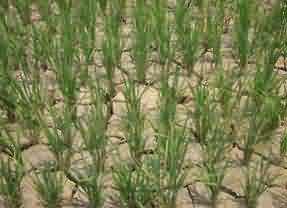
The eastern region comprises of Bihar, Eastern Uttar Pradesh, Odisha, West Bengal Jharkhand, Chhattisgarh and plains of Assam, represents 21.85% geographical area of the country and supports to 33.64% of country production.
Most of the current high-yielding varieties of rice grown in rainfed areas are varieties bred for irrigated ecosystems and they are highly susceptible to water scarcity (drought) condition.
Keeping this fact in view, there is urgent need to disseminate and adoption of high yielding drought tolerant varieties to achieve food self sufficiency at national level from eastern region.
Water requirement of puddled irrigated and rainfed upland rice
Studies across the country indicate that puddled irrigated rice requires about 900-2250 mm of water (average 1500 mm) depending on the management, soil and climatic conditions (Table 1).
Rainfed upland rice grown under aerobic condition without irrigation and puddling. It requires about 900-950 mm of water. Pot experiments and greenhouse studies revealed that rice plants growing under a range of water application transpired 500-1000 litres of water to produce 1 kg of rough (un-milled) rice.
Table 1. Comparison of water requirement between puddled irrigated rice and rainfed upland rice
|
Purpose of water use |
Puddled irrigated rice (mm) |
Rainfed upland rice |
|
|
Low |
high |
||
|
Land preparation |
150 |
250 |
100 |
|
Evapo-transpiration |
500 |
1200 |
500 |
|
Seepage and percolation |
200 |
700 |
300 |
|
Mild season drainage |
50 |
100 |
50 |
|
Total water requirement |
900 |
2250 |
950 |
Status of drought tolerant rice varieties
Despite the importance of drought as a constraint, little effort has been devoted to developing drought-tolerant rice cultivars. Most of the high-yielding varieties— IR36, IR64, Swarna, and Sambha Mahsuri—grown in rainfed areas, are varieties developed for irrigated ecosystems and they were never selected for drought tolerance.
Farmers of drought-prone areas require varieties that provide them with high yield in years of good rainfall and sustainable good yield in years with drought.
In rainfed areas, upon failure of rain or a long spell between two rains, drought stress can occur at the seedling, vegetative, and reproductive stage of the rice crop or it can be intermittent drought depending upon the rainfall pattern and distribution.
Among all these, drought at the reproductive stage has been identified as the most detrimental to grain yield. Moreover, in most rainfed regions, the probability of occurrence of terminal reproductive-stage drought is high due to the early withdrawal of monsoon rains.
By employing direct selection for grain yield under drought, several promising breeding lines for rainfed lowlands and uplands have been identified recently. Similarly, some drought tolerant varieties (Sahbhagi dhan, Susk Samrat, CR dhan, Anjali, Vandana and Indira Barani dhan) are already released for eastern India (Table 2)
Drought tolerant rice varieties for cultivation in eastern region
Most of the traditional high yielding varieties of eastern region viz., IR 64, IR 36, Swarna, Sambha Mahsoori, Savitri, Sarjoo-52, Rajendra Subhasani and Rajendra sweta are highly susceptible to water scarcity (drought) condition. In recent years, there are several varieties such as Sahbhagi dhan, Shushk Sanrat, CR dhan 40, NDR 97, Indira Barani dhan etc. have been developed for drought prone area of eastern states (Table 2).
Cultivation of these drought tolerant varieties will be helpful for sustaining food security in eastern states. Details of these drought tolerant rice varieties are as follows:
1. Sahbhagi Dhan:
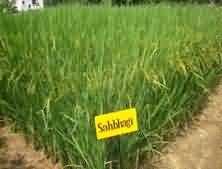 This variety has been developed by CRURRS, Hazaribag in collaboration with International Rice research Institute (IRRI), Manilla, Philippines. It has been released and notified in 2009 and 2010, respectively.
This variety has been developed by CRURRS, Hazaribag in collaboration with International Rice research Institute (IRRI), Manilla, Philippines. It has been released and notified in 2009 and 2010, respectively.
It is highly drought tolerant variety and recommended for cultivation in rainfed upland and lowland areas of eastern states, particularly in Jharkhand, Bihar, UP and Odisha.
Sahbhagi dhan is maturing in 105-110 days in plain areas and 110-115 days in upland. Transplanting of this variety should be done between mid-Junes to first week of July.
Seed of sahbhagi dhan is long and bold and having intermediate amylose content and high HRR. Sahbhagi dhan is highly resistant to leaf blast and moderately resistant to brown spot and sheath blight. Productivity of sahbhagi dhan is 2.0-2.5 t/ha under drought stress and 3.8-4.5 t/ha without stress.
2. Shusk Samrat:
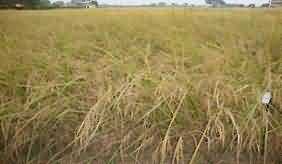 Rice variety Shusk Samrat has been developed by Narendra Dev University, Masoda, Faizabad for drought prone rainfed upland and lowland areas of eastern Uttar Pradesh, Bihar and Chhattisgarh. Besides drought tolerant ability,
Rice variety Shusk Samrat has been developed by Narendra Dev University, Masoda, Faizabad for drought prone rainfed upland and lowland areas of eastern Uttar Pradesh, Bihar and Chhattisgarh. Besides drought tolerant ability,
it also shows tolerance for low fertilizer stress and responsive to favorable condition.
Shusk Samrat having semi dwarf (95-100 cm) stature, with 8-10 panicle bearing tillers plant-1, early maturity (110-115 days), high yielding ability and good grain quality.
Further, its short growth duration and high harvest index give better opportunities for double cropping in drought-prone areas of eastern India. Shusk Samrat performed well under aerobic conditions too.
It is moderately resistant to major insects and pests such as stem borers, gall midge, leaf folders, and whorl maggots. It is also resistant to sheath rot and brown spot and moderately resistant to sheath blight.
3. CR Dhan 40
This variety has been developed by CRURRS, Hazaribag for drought prone upland areas of Jharkhand, Bihar and Maharashtra. CR dhan 40 is drought tolerant, medium-tall (115-120 cm) and early maturing (95-100 days) variety.
Grain type of this variety is short bold, having high HRR. Yield potential of CR dhan is 3.0 and 4.0 t ha-1 under direct seeded and transplanted condition, respectively. It is moderately resistant to brown spot and leaf blast.
4. Vandana
Rice variety Vandana has been developed for drought prone rainfed upland areas of Jharkhand, Bihar, Odisha and Chhattisgarh. It is drought tolerant, tall (100-110 cm) and early maturing (90-95 days) and deep rooted variety. Grain type of this variety is long bold.
Yield potential of Vandana is 2.5-3.0 and 3.5-4.5 t ha-1 under direct seeded and transplanted condition, respectively. Besides drought tolerant, it is also weed competitive variety. It is moderately resistant to brown spot and blast.
5. Anjali
This variety has been developed by CRURRS, Hazaribag for drought prone upland areas of Bihar, Jharkhand, Odisha, Assom and chhattigarh states of eastern region. It has been released and notified in year 2002. Rice variety Anjali is drought tolerant, semi-tall (85-90 cm) and early maturing (95-95 days) variety. Grain type of this variety is short bold.
Its yield potential is 3.0 and 4.0 t ha-1 under direct seeded and transplanted condition, respectively. It is highly resistant to brown spot & gall midge biotype 5 and 1and moderately resistant to leaf blast.
6. Indira Barani dhan-1
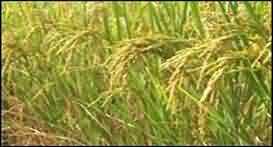 This variety has been developed by Indira Gandhi Krishi Viswavidyalaya (IGKV), Raipur, for rainfed shallow lowland ecosystem of Chhattisgarh state. This variety Indira Barani dhan-1 possesses medium slender grain with golden husk, high head rice recovery (65%) and intermediate amylase content (24.7).
This variety has been developed by Indira Gandhi Krishi Viswavidyalaya (IGKV), Raipur, for rainfed shallow lowland ecosystem of Chhattisgarh state. This variety Indira Barani dhan-1 possesses medium slender grain with golden husk, high head rice recovery (65%) and intermediate amylase content (24.7).
This rice variety is mature in 111-115 days. Transplanting should be done between third to fourth week of June to obtain the potential yield from the variety.
This variety is also suitable for aerobic condition. Under favorable condition the yield potential of rice variety Indira Barani dhan-1 is 4.0-4.5 t/ha. For weed management, 1.0 kg a.i/ha pendimethaline should be applied as preemergence (3-5 days after transplanting) in moist field condition.
Indira Barani dhan-1 is highly resistant to bacterial leaf blight, brown spot and stem borer disease and insect pest.
Diseases associated with drought-stress tolerant rice varieties
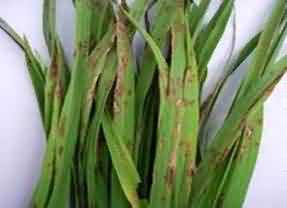 High incidences of blast (caused by Pyricularia grisea) and brown spot (caused by Helminthosporium oryzae) have been observed in drought screens. Drought-tolerant lines promoted at the advanced stage should possess tolerance of blast and brown spot.
High incidences of blast (caused by Pyricularia grisea) and brown spot (caused by Helminthosporium oryzae) have been observed in drought screens. Drought-tolerant lines promoted at the advanced stage should possess tolerance of blast and brown spot.
Further, as the field selected for a drought screen is kept under aerobic conditions for more than two thirds of crop duration, incidences of nematode (Meloidogyne graminicola) development have been observed in such fields.
It is suggested to change drought-screen fields every 3 years if possible. In situations where fields cannot be changed, soil treatment with nematicide is recommended and fields should be planted with legumes in the off-season.
Table 2: Rice varieties for drought prone areas of eastern states of India
|
Varieties |
50% flowering (days |
Plant height (cm) |
Maturity (duration) |
Yield (q/ ha) |
Grain type |
Favorable land for cultivation |
Recommended state for cultivation |
Resistant/ Tolerant |
|
|
Stress |
Non-stress |
||||||||
|
Sahbhagi dhan |
85-90 |
110-120 |
110-115 |
25-30 |
40-45 |
Long -bold |
Rainfed upland & medium lowland |
Odisha, Bihar, Jharkhand, eastern UP and West Bengal |
Leaf blast, brown spot and sheath blight |
|
Shushk Samrat |
85-90 |
110-120 |
110-115 |
25-30 |
35-40 |
Long -slender |
Rainfed upland & medium lowland |
Eastern UP, Bihar, Jharkhand and Odisha |
Moderate resistant to brown spot and leaf blast |
|
CR dhan 40 |
75-80 |
115-120 |
95-100 |
25-30 |
35-40 |
Short-bold |
Rainfed upland (direct seeded) |
Jharkhand & Bihar |
Moderate resistant to brown spot and leaf blast and complete resistant to gall midge |
|
Narendra dhan 97 |
75-80 |
80-85 |
95-100 |
20-25 |
30-40 |
Long -slender |
Rainfed upland & medium lowland |
UP, west Bengal, Bihar and Chhattisgarh |
Brown spot, blast and sheath rot |
|
Narendra dhan 118 |
70-75 |
95-100 |
90-95 |
20-25 |
30-35 |
Medium selender |
Rainfed upland & medium lowland |
Uttar Pradesh & Bihar |
Moderate resistant to brown spot and leaf blast |
|
Anjali |
65-70 |
85-100 |
90-95 |
25-30 |
35-40 |
Short-bold |
Rainfed upland |
Bihar, Odisha, Jharkhand, Assom & Chatishgarh |
Resistant to brown spot and gall midge and moderately resistant to leaf blast; |
|
Vandana |
70-75 |
100-105 |
95-100 |
25-30 |
35-45 |
Long -bold |
Rainfed upland |
Jharkhand, Bihar, Odisha & Chatishgarh |
Resistant to termite, brown spot and leaf blast |
|
Hazaridhan |
80-85 |
90-95 |
115-120 |
20-25 |
35-45 |
Long-slender |
Rainfed upland & lowland |
Jharkhand & Bihar |
Resistant to brown spot and leaf blast and moderate resistant to leaf blight |
|
Indira Barani dhan |
82-87 |
100-105 |
111-115 |
25-30 |
40-45 |
Long-slender |
Rainfed upland & medium lowland |
Chhattisgarh & MP |
Resistant to brown spot, BLB, leaf blast and stem borer |
|
Naveen |
90-95 |
90-95 |
120-125 |
20-25 |
35-40 |
Long-slender |
Rainfed upland & medium lowland |
Odisha & Jharkhand |
Resistant to bacterial leaf blight and sheath blight |
Summary
The challenge of growing water scarcity and frequent occurrence of drought has been identified as the key to low rice productivity in rainfed ecosystems of eastern region, threatening food security.
Because of absence of high yielding, good quality drought tolerant varieties, farmers in rainfed ecosystem continue to grow traditional varieties, leads to high yield losses.
Adoption of high yielding drought tolerant rice varieties Sahbhagi dhan, Shusk samrat, CR dhan 40, Vandana, Anjali, Naveen and Indira Barani dhan will play pro-active and decisive role in developing sustainable food production and lead for food security among farm families in the stress (water scarcity) prone areas of eastern region of India.
Authors:
Santosh Kumar, S. K. Dwivedi, S. S. Singh, S. Mondal and B. P. Bhatt
ICAR Research Complex for Eastern region, Patna-800014
Email:
